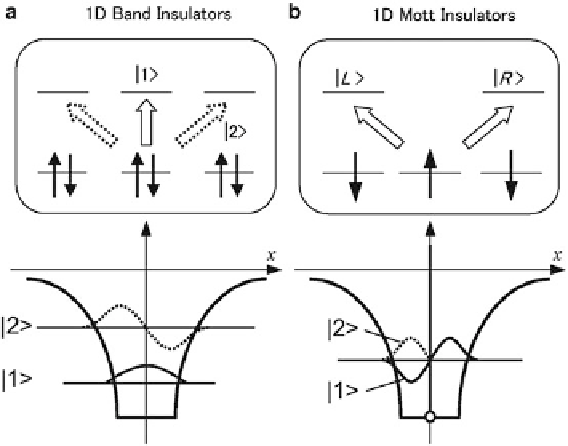Chemistry Reference
In-Depth Information
Fig. 7.7 Schematics of the excited states in 1D band insulators (a) and 1D Mott insulators (b).
From [
10
]
plotted versus the optical gap energy. The absolute values of
DE
for Ni-X chain
compounds and 1D cuprates are small, indicating that two excited states |1
>
and
|2
>
are nearly degenerate. On the other hand,
DE
is relatively larger in Pt-X chain
compounds and conjugated polymers (
DE ¼
0.2-1.0eV) than
DE
in Ni-X chain
compounds.
DE
tends to increase with the increase of the optical gap energy not
only in Pt-X chains and conjugated polymers but also in Ni-X chains. In Ca
2
CuO
3
,
it was revealed that the excitonic effect is negligibly small and the spectrum of
w
ð
3
Þ
as well as of
e
2
is very broad. Therefore, the three-level model assuming the two
discrete excited states would not be sufficient to explain the optical responses. This
is the reason why
DE
is negative (~
0.2 eV).
In Fig.
7.6c
,
<
1
jxj
2
>
values are plotted versus
<
0
jxj
1
>
for various 1D
semiconductors. Data points of
in 1D Mott insulators (Ni-X chain
compounds and 1D cuprates) are located on the same line, while data points of
Peierls and band insulators (Pt-X chain compounds and conjugated polymers) are
located on the different line. The slope,
<
1
jxj
2
>
, is larger for 1D Mott
insulators. Thus, the difference between 1D Mott insulators and the other 1D
semiconductors is clear.
These two features, that is, the small
<
1
jxj
2
>=<
0
jxj
1
>
, in 1D Mott
insulators are not observed in 1D Peierls and band insulators. They originate from
strong electron correlation [
16
]. Here, let us briefly discuss the difference of
electronic excited states between 1D band insulators and 1D Mott insulators. In
Fig.
7.7a
, we show the schematics of the electronic structure and excited states in a
1D band insulator by using a molecular orbital picture [
10
,
16
]. In a 1D band
DE
and the large
<
1
jxj
2
>

Search WWH ::

Custom Search